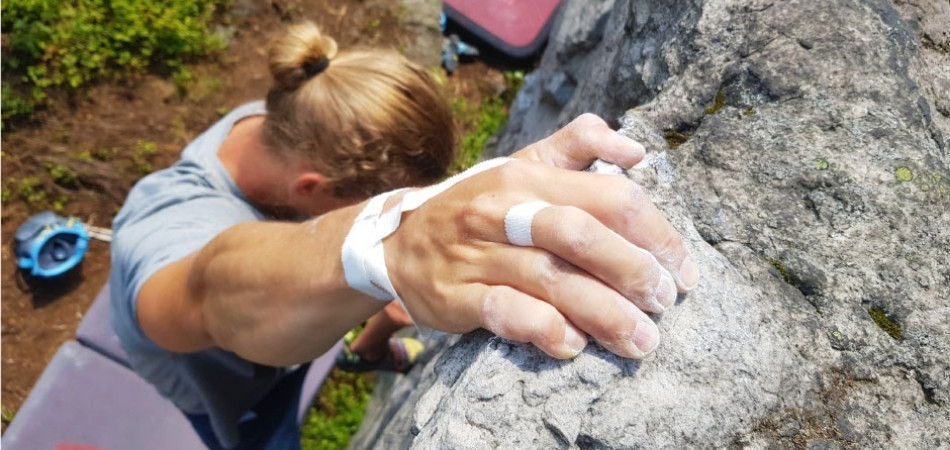Bouldering Hand Care and Climbing- How to Tape Flappers to an Palm
If you've got flappers on your palm, your first instinct is to use flapper tape. This technique uses more tape than a ring that wraps around your palm. The tape ring tends to slip as you climb, pulling down your palm while grabbing a hold. A flapper tape ring will stay in place, but it's easier to slip off if you climb with your palm open.
This post is not about healing flappers
While this post is not about healing flappers while climbing and bouldering, it does provide general information for the sake of clarity. Washing your hands with soap and water is crucial. Not only will it remove chalk residue, but it will also minimize the amount of time you spend exposing yourself to drying agents and bacteria. Hot water is also not a good idea, as it will strip away natural oils from your skin.
If you're interested in continuing climbing after healing your flapper, you can use tape to keep it in place. However, it's important to note that it will take some time for your flapper to heal completely. If you're keen on continuing to climb with a flapper, you can use crimps or climbing tape to hold it down. If the flapper is too big or uncomfortable to reattach, you can use climbing tape.
What is a flapper
If you're a new climber, you may be wondering what a flapper is and how to tape it to your palm. Flappers are painful injuries caused by excessive calluses that have built up on your hand from too much climbing. They can cause the area between your finger and hold to become pinched. The skin underneath can become extremely painful if the flapper is dry. To prevent this problem, you can apply climbing balm on the flapper.
While this may sound like an incredibly simple solution, it can create more problems than it solves. First of all, the flapper will be much more likely to develop an infection if you don't clean it properly. Climbers can't stop and take the time to clean the flapper. It will need to be cleaned with a wound cleansing substance and will require tape removal. Besides, it's a time-consuming process.
Longterm flapper prevention
Identifying a potential flapper is vital for longterm prevention when climbing and bouldering. The first step is to keep your hand dry and clean and avoid over-filing your calluses. If you are already aware of a potential flapper, avoid it as much as possible by not climbing during a flare-up. If the callus grows larger, you may need to upgrade your file.
Another method is to use climbing tape to patch up the flapper. You can use this technique the same way you would repair a dented bike. A little bit of climbing tape and a few days off will make a big difference. Once the flapper is healed, try to avoid climbing with it for at least a few days. If you don't want to deal with it for long, cut it off at the edges and keep it covered with climbing tape.
Another method of longterm flapper prevention is to clean the flapper after climbing. To clean it, use a hand soap. The tape should be loose enough that it doesn't stick to the flapper. Make sure to peel the tape off carefully, to avoid uncomfortable tautness and to protect the flapper's blood supply. It's also possible to use antiseptic cream or powder to clean the flapper, though opinions vary.
Quick 2 minute routine before bed for Longterm
As you climb, your hands will be constantly exposed to the elements. If you're prone to calluses, you may want to try sanding your hands to reduce the surface area. It's also a good idea to avoid hot showers, which can make calluses rip off. Also, don't forget to moisturize your hands, which can help prevent calluses from occurring in the first place.
After climbing for several days, you'll notice that your fingers and hands are dry and brittle. Try applying a hand salve to the skin on your hands to help the wound heal faster. You'll also want to file calluses off with sandpaper or pumice stone, as this will help remove weak parts of the skin. The next day, make sure you've applied sunscreen.
Before climbing, be sure to moisturize your hands with a good hand cream. Moisturizing your hands will help make them less prone to cracking, since they're more elastic. Remember, your skin is your largest organ and needs moisture to regenerate. After climbing, use an oil-lotion or hand cream to keep your hands hydrated and prevent calluses. Your skin will also benefit from a hand cream, which will help protect your hands from the damaging effects of dry skin.
When the flapper happens
When the flapper happens when climbing and bouldered, the first thing you should do is make sure to keep your hands clean and dry. This is the best way to reduce the chances of developing a flapper. Flappers are caused by tearing the skin, so be sure to check your hands frequently, especially after climbing. Once you have spotted a potential flapper, avoid climbing or bouldering for a few days. If the flapper is already present, use h tape to protect the area. Make sure to check for rough edges and calluses when you're climbing, because they're easily caught on hold surfaces. Beginners should also be especially careful, as well as people who've taken a long break from climbing.
If you intend to climb again soon, you can use climbing tape to keep the flapper moist. You should not apply the sticky side of the tape directly to the wound, as it can tear it. Instead, place a piece of soft material between the tape and the flapper. After removing the tape, the flapper will heal more quickly. After this, apply climbing salves or balm to the area to help with the healing process.
Cut off edges
To prevent further tearing, it is a good idea to cut off the edges of your flappers. You can use a nail clipper or scissors to cut off the flappers. Then, chew on the edges of the flapper until you no longer feel any pain. If you leave the flapper with some skin, you can treat it with chalk or other climbing salves.
Climbers tend to have callouses on their hands, a layer of skin that forms over the old. After climbing for 100 times, calluses can accumulate on the skin. To prevent them from tearing, climbers should sand off the edges of the callous. This will create a smoother edge where the regular skin meets the callous. This will make the skin more resilient to tear.
Split tips are another common problem among climbers. They can interfere with the grip and can tear easily if caught on a hold. If you are prone to splitting tips, consider using a repairing hand cream to smooth them out. However, never apply a moisturizing cream right before climbing. In addition, you should also avoid licking your hands with chalk after a climbing session.
Cheap option: Vetbond or liquid bandages
If you're looking for a cheap alternative to superglue, you may want to consider using a bandage made of Vetbond or liquid. These will not rip, stick together well, and are flexible enough to be used on the fingers and hands. In addition, they are also great for sealing open tips. And, they are relatively inexpensive - less than a dollar each.
Using Vetbond or liquid bandages is a good way to treat a split or other wound on your hands, but you should know that it might take up to a week to heal completely. After the wound has healed, the skin will be vulnerable to re-injury, so it's important to rest and give it time to heal. When it comes to climbing fingertips, you might notice that the skin has split and is turning pink, with clear fluid coming out. If this happens, it's time to take some time off and let the skin heal.
For more serious hand injuries, a climbing tape may be your best bet. These sticky, adhesive bandages have a rubber backing that can help increase friction and cover worn-out tips. They also help prevent tears and splits. To prevent any future hand injuries, always practice the sport properly to maintain healthy skin and avoid further damage to your hands. Even if you are careful, too much climbing can cause problems. Make sure to limit the intensity of your climbing and bouldering sessions.
How to use Skinglue like Dermabond & Vetbond
There are many ways to apply surgical glue to your hands, but the two most common ones are Dermabond and Vetbond. Both are cyanoacrylate glues, which form a strong, waterproof bond when mixed with water. The difference between these two glues is the safety of each. Vetbond is not FDA-approved for human use, while Dermabond is made for animals. While it's safe for human use, its adverse effects on animals can lead to skin necrosis.
Using a skin glue such as Dermabond or Vetbond is an essential part of your climbing and bouldering hand care. These adhesives harden instantly when they come into contact with blood or water, so they are excellent for preventing bleeding and wounds. Using a Skinglue like Dermabond or Vetbond on your hands can be effective and quick.


Comments
Post a Comment